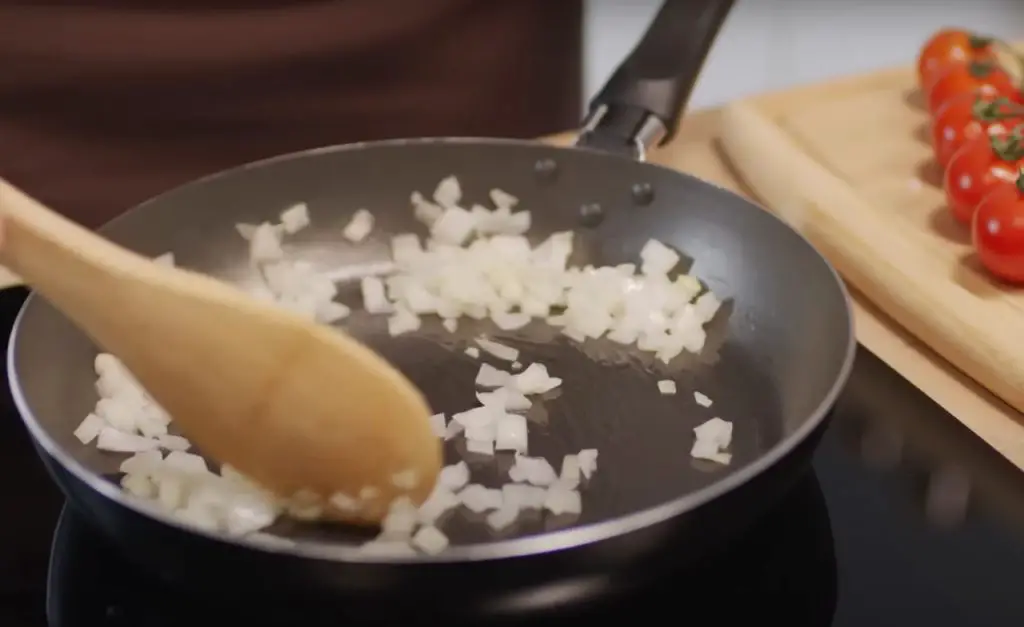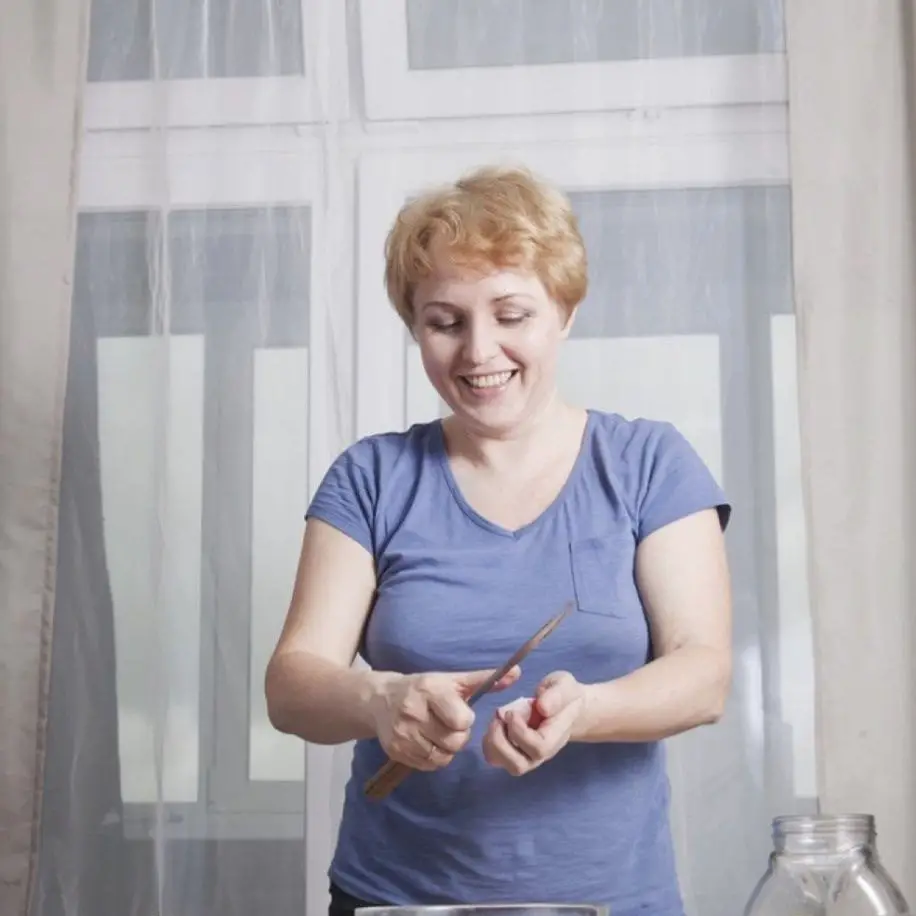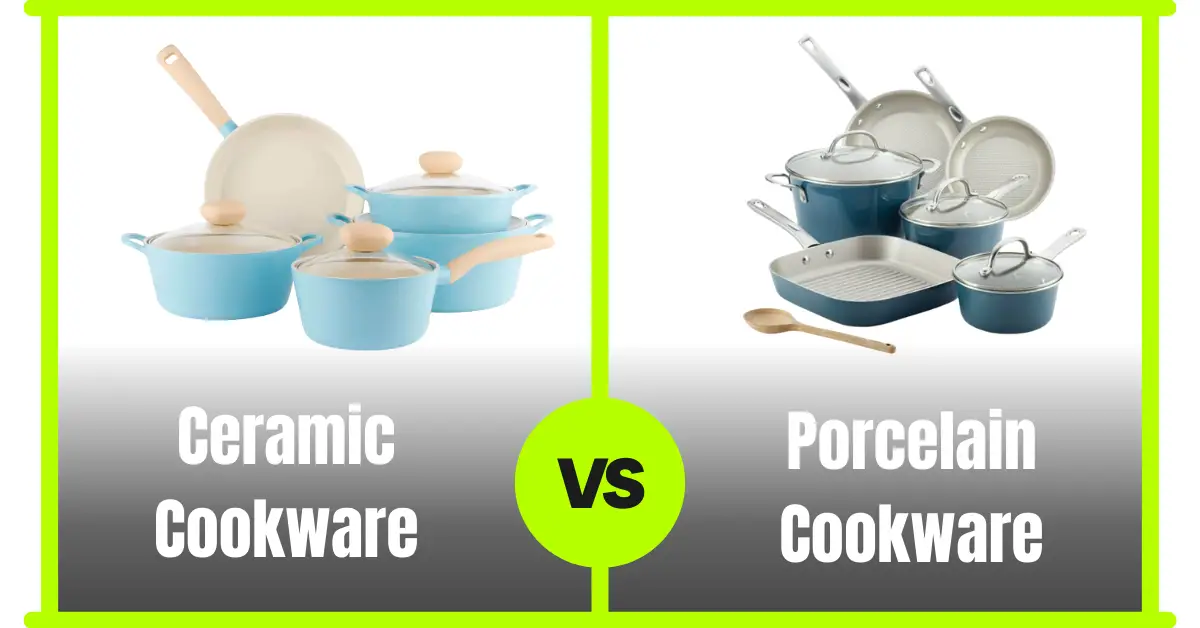Ceramic and Porcelain cookware have advantages and disadvantages, but which is the better material for cookware? In this article, we have compared ceramic and Porcelain cookware and found their differences and similarities.
Ceramic vs. Porcelain Cookware

| Ceramic Cookware |
|---|
| Material: Made from clay, water, and other natural minerals. |
| Weight: Heavy. |
| Non-stick: Natural non-stick surface. |
| Design: Rustic or earthy look, with a matte or semi-gloss finish. |
| Durability: Less durable than Porcelain. |
| Heat resistance: High heat resistance but can be susceptible to cracking. |
| Price: Cheap and Affordable. |

| Porcelain Cookware |
|---|
| Material: Made from a specific type of clay called kaolin (white clay). |
| Weight: Lightweight. |
| Non-stick: Coated with a non-stick layer |
| Design: More refined and elegant appearance due to its smooth, glossy finish. |
| Durability: Durable than ceramic. |
| Heat resistance: Withstand higher temperatures. |
| Price: Expensive. |
Material
Ceramic cookware is made from clay, water, and other natural minerals, fired at high temperatures to create a hard, durable surface. Porcelain cookware, on the other hand, is made from a specific type of clay called kaolin, combined with feldspar and other minerals. It is also fired at extremely high temperatures, producing a more dense and durable material.
Heat resistance
Porcelain cookware can withstand temperatures higher than ceramic cookware, making it suitable for use on stovetops, ovens, and grills. While heat-resistant, ceramic cookware can be more susceptible to thermal shock and cracking if exposed to sudden temperature changes.
Weight
Ceramic cookware tends to be heavier than porcelain cookware due to its thicker construction. This can make handling more difficult, especially when cooking with large or heavy pots and pans.
Durability
Porcelain cookware is generally more durable than ceramic, as it is less prone to chipping, cracking, or staining. This makes it more suitable for heavy use and long-term wear and tear.

Non-stick properties
Ceramic cookware often features a natural non-stick surface, making it ideal for cooking with less oil or fat. Porcelain cookware may not have the same natural non-stick properties, but it can be coated with a non-stick layer to enhance performance.
You may also like to read: How To Make A Ceramic Pan Non Stick Again
Design
Both ceramic and Porcelain cookware can be found in various colors and designs. Still, Porcelain is often considered to have a more refined and elegant appearance due to its smooth, glossy finish. Ceramic cookware has a more rustic or earthy look with a matte or semi-gloss finish.
Price
Ceramic cookware is generally more affordable than porcelain cookware, making it a popular choice for budget-conscious consumers. With its greater durability and refined appearance, porcelain cookware tends to command a higher price point.
Frequently Asked Question
Which is better ceramic or Porcelain cookware?
Ceramic cookware is better than porcelain cookware. Because ceramic cookware has a PFOA and PTFE-free non-stick cooking surface, the price is also very cheap compared to porcelain cookware. But if you want lightweight and durable cookware, go with porcelain cookware.
Is porcelain enamel better than ceramic?
Ceramics is better than Porcelain. But both materials have their unique strengths and weaknesses.
For example, Porcelain enamel is more durable and resistant to scratches and stains. It also retains heat well, making it great for cooking stews and braises.
On the other hand, ceramic cookware is lighter and easier to handle. It’s also non-reactive, so you can cook acidic foods without worrying about a metallic taste.
So ultimately, the choice between porcelain enamel and ceramic comes down to your preferences and cooking habits.
Is porcelain cookware healthy?
Yes, porcelain cookware is healthy. Because Porcelain cookware is made of white clay, which is non-reactive, meaning it doesn’t interact with or leach chemicals into the food when cooking.
Is Porcelain Safer Than Ceramic?
Both materials are safe for cooking. The safety of the cookware largely depends on the quality of the materials used and whether they meet safety standards. Choosing cookware from reputable manufacturers that adhere to safety regulations and use non-toxic glazes and coatings is important.
Which is more expensive ceramic or Porcelain?
Porcelain cookware is generally more expensive than ceramic cookware. This is primarily due to the higher cost of manufacturing porcelain.
Porcelain is fired at a higher temperature and requires a more intricate production process, resulting in a denser and more durable material.
The additional steps and higher quality standards in producing Porcelain contribute to its higher price than ceramic cookware.
Is Porcelain more heat resistant than ceramic?
Yes, Porcelain is generally more heat resistant than ceramic. Porcelain is fired at higher temperatures during its manufacturing process, which results in a denser and more durable material. This high firing temperature makes Porcelain more capable of withstanding higher heat levels than many other ceramic types.
The higher heat resistance of Porcelain makes it suitable for use in various cooking applications, including stovetop cooking and oven baking. It can withstand high temperatures without cracking or warping, providing reliable performance in the kitchen.
Is Porcelain safe for food?
Yes, Porcelain is safe for food. Because Porcelain is a non-reactive material and the non-stick coating is PFOA and PTFE-free.

I am Linda. A housewife and a writer, and also the founder of this site. I love cooking and collecting cookware sets. I’ve been blogging since 2020, and in this blog, you can find cookware-related problems and solutions, cookware reviews, safe cookware sets, and more.
I have put a lot of effort into gathering here the experience and knowledge that I have, and I want to help every reader.


